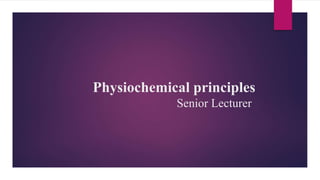
Lec # 4- structure of cell membrane
- 2. Structure of cell membrane Fluid mosaic model Fluid mosaic model was discovered by S. J. Singer and G. L. Nicolson in 1972. This model explains well the architecture of cell membrane.
- 3. Biological membranes can be considered as a two dimensional liquid in which lipid and protein molecules diffuse more or less easily.
- 5. Lipid bilayer Cell membrane is a lipid bilayer structure. Phospholipids form a bilayer in which the nonpolar regions (tails) of the lipid molecules in each layer face the core of the bilayer.
- 6. And their polar head groups face outward, interacting with the aqueous phase on either side.
- 8. In the lipid bilayer, proteins are embedded at irregular intervals. These proteins are held in place by hydrophobic interactions between them and the membrane lipids. Some proteins span the whole thickness of the membrane.
- 9. While others span partially, protruding either on the exterior or the interior of the cell membrane.
- 10. The orientation of proteins in the bilayer is asymmetric, giving the membrane “sidedness”: the protein domains exposed on one side of the bilayer are different from those exposed on the other side, reflecting functional asymmetry.
- 11. The irregular distribution of proteins in the lipid bilayer gives it the so called mosaic appearance. However, the mosaic is not constant but is fluid, i.e. changeable from moment to moment.
- 12. The fluidity of the mosaic is due to weak (non-covalent) interactions between lipid and protein molecules that enable individual lipid and protein molecules to move free laterally in the plane of the membrane.
- 13. A lipid bilayer is the basic structural element of membranes Lipids (glycerophospholipids, sphingolipids, and sterols) are virtually insoluble in water. When mixed with water, they spontaneously form microscopic lipid aggregates.
- 14. Depending on the precise conditions and the nature of the lipids, three types of lipid aggregate can form when amphipathic lipids (all lipids in membrane because they have hydrophilic and the hydrophobic end) are mixed with water.
- 15. These are: a. Micelle b. Bilayer c. Vesicle
- 16. a. Micelle Micelles are spherical structures that contain anywhere from a few dozen to a few thousand amphipathic molecules.
- 17. These molecules are arranged with their hydrophobic regions aggregated in the interior, where water is excluded.
- 18. And their hydrophilic head groups at the surface are in contact with water. Micelle formation is favored when the cross-sectional area of the head group is greater than that of the acyl side chain(s), as in detergents such as sodium dodecyl sulfate.
- 19. b. Bilayer A second type of lipid aggregate in water is the bilayer, in which two lipid monolayers (leaflets) form a two dimensional sheet. The hydrophobic portions in each monolayer is excluded from water and interact with each other.
- 20. The hydrophilic head groups interact with water at each surface of the bilayer.
- 21. Bilayer formation is favored if the cross-sectional areas of the head group and acyl side chain(s) are similar, as in glycerophospholipids and sphingolipids.
- 22. c. Vesicle The bilayer sheet is relatively unstable and spontaneously folds back on itself to form a hollow sphere that is called a vesicle because the hydrophobic regions at its edges are in contact with water.
- 23. The continuous surface of vesicles eliminates the exposed hydrophobic regions, allowing bilayers to achieve maximal stability in their aqueous environment.
- 24. Vesicle formation also creates a separate aqueous compartment.
- 25. Membrane proteins There are three types of membrane proteins that differ in their association with the membrane. 1. Integral membrane proteins 2. Peripheral membrane proteins 3. Amphitropic proteins
- 27. 1. Integral membrane proteins Integral membrane proteins or intrinsic proteins are very firmly associated with the lipid bilayer, and are removable only by agents that interfere with hydrophobic interactions, such as detergents, organic solvents, or denaturants.
- 28. 2. Peripheral membrane proteins Peripheral membrane proteins or extrinsic proteins associate with the membrane through electrostatic interactions and hydrogen bonding with the hydrophilic domains of integral proteins and with the polar head groups of membrane lipids.
- 29. ' They can be released by relatively mild treatments that interfere with electrostatic interactions or break hydrogen bonds; a commonly used agent is carbonate at high pH.
- 30. 3. Amphitropic proteins Amphitropic proteins are found both in the cytosol and in association with membranes. These are sometime attach with membranes and sometimes not depending on some type of regulatory process such as reversible palmitoylation. Their affinity for membranes results in some cases from
- 31. And in other cases from the presence of one or more lipids covalently attached to the amphitropic protein.